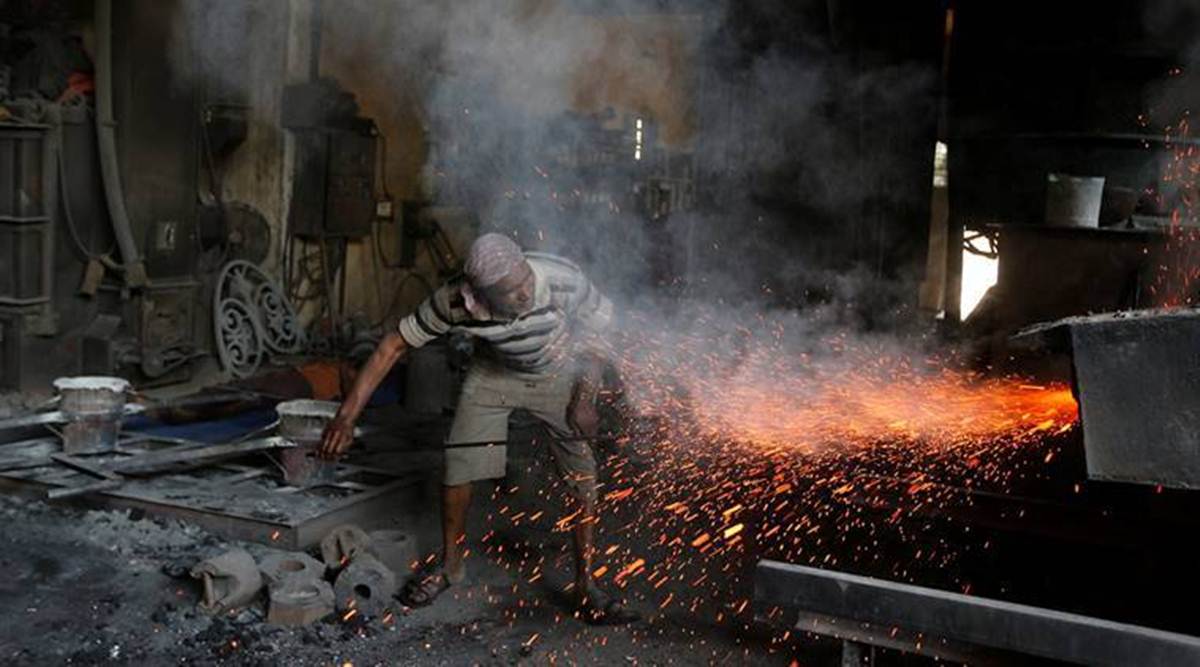 The April-June Gross Domestic Product (GDP) will mark India’s entry into a recessionary phase — with two consecutive quarters of GDP contraction, the trend is expected to continue in the July-September quarter as well. (File)
The April-June Gross Domestic Product (GDP) will mark India’s entry into a recessionary phase — with two consecutive quarters of GDP contraction, the trend is expected to continue in the July-September quarter as well. (File)The April-June Gross Domestic Product (GDP) will mark India’s entry into a recessionary phase — with two consecutive quarters of GDP contraction, the trend is expected to continue in the July-September quarter as well.
With economic activity severely disrupted in the first two months of this fiscal, hit hard by a series of localised lockdowns and rising Covid-19 cases, GDP contraction for the first quarter is being pegged at an average 20 per cent by economists, with the de-growth range between 15.2 per cent and 25.5 per cent.
The National Statistical Office (NSO) will release data for April-June Monday which is expected to be the worst since India started reporting quarterly data in 1996. The UK economy has seen the biggest slump in June quarter GDP among the top 20 global economies, with a 21.7 per cent annual contraction in growth — its deepest recession on record.
Experts, however, warn that the numbers are unlikely to capture the real extent of the economic crisis, given that the small-scale sector and informal sector are more affected than the organised sector. This distress will not get reflected in the GDP numbers as factory output figures are used to extrapolate trends in the informal sector.
Weak investment, capital spending and consumption demand have hit manufacturing, construction, tourism and transport sectors even as agricultural growth is seen around 3-4 per cent in the April-June quarter.
ExplainSpeaking | What to look for in GDP data
Recovery in the second quarter has also not picked up as expected with various states announcing lockdowns in July and August. Looming defaults — after the moratorium ends — are adding to the banking sector’s woes which could further crimp lending.
On top of this, are worries over household debt with incomes stagnating, salary cuts and job losses across the board.
As per the Centre for Monitoring Indian Economy (CMIE), salaried jobs suffered the biggest hit during the lockdown, with total loss estimated to be at 18.9 million during April-July.
A consumption boom is ruled out given the rising household debt along with reluctance of banks to lend. Former Chief Statistician of India Pronab Sen put the de-growth estimate for April-June to be around (-) 20 per cent, adding that even this does not capture the real depth of the pandemic’s impact on the MSME sector and agricultural incomes.
Also, in a trend reminiscent of demonetisation, corporates have fared better than MSMEs, which are in a far worse situation which along with a weakness in farm incomes is also expected to hit demand further in the coming year, he added.
Barclays has projected the economy to contract 25.5 per cent in April-June; ICRA’s estimate is 25 per cent; HDFC Bank has pegged it at 21 per cent State Bank of India has projected a 16.5 per cent contraction, while India Ratings has put it at 17.03 per cent. Nomura has pegged its estimate at 15.2 per cent while DBS expects a contraction of 16.6 per cent.
Said Radhika Rao, Economist, DBS: “The first quarter bore the most brunt of the stringent lockdown in response to the pandemic, beyond which authorities weighed the trade-off between economic costs of extending the lockdown or prioritising health. This led to an incremental and gradual reopening at a varied pace across different states/ districts.
While Q1 data is backward looking, it was the likely nadir of the downcycle, with shallower contraction expected over the next two quarters. For the path ahead, sustainability of the recovery cycle is contingent on when the epidemic curve successfully flattens.”
Though rural demand is expected to support economic recovery, it cannot substitute urban demand, India Ratings said in a note. “The COVID-19 led business disruptions during end-March-May 2020 have been so severe for the production, supply/trade channels and the activities especially in sectors such as aviation, tourism, hotels and hospitality that FY21 GDP growth is expected to contract for the first time since FY’80. Although non-agricultural economic activities are slowly limping back, they are still much lower than pre-COVID-19 level,” it said.
The government’s stretched fiscal position means its ability to spend is compromised. States, which account for a cumulative spending of about one-and-half times more than the Central government, are also facing strain on their finances amid subdued economic activity and an estimated Rs 2.35 lakh crore compensation shortfall under GST. Over-leveraged corporate balance sheets means private investment will continue to sag. The corporate tax cut last year were largely futile given that companies used it to reduce debt and build up cash balances, the Reserve Bank of India said in its Annual Report 2019-20.
The RBI refrained from giving any estimate for the GDP but said that the assessment of aggregate demand during the year so far suggests that “the shock to consumption is severe, and it will take quite some time to mend and regain the pre-COVID-19 momentum”.